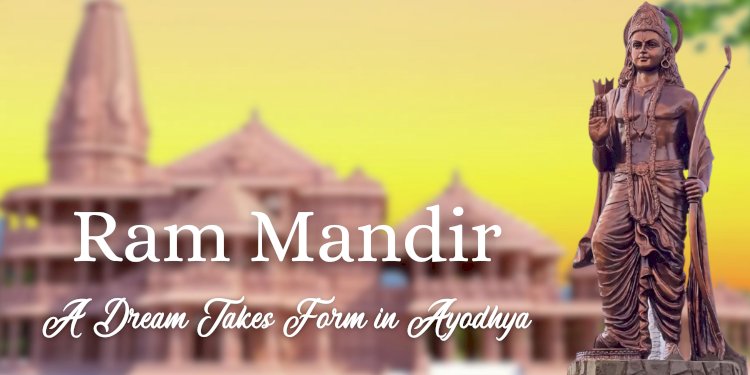Ram Mandir: A Dream Takes Form in Ayodhya
The Ram Mandir at Ram Janmabhoomi, Ayodhya, encapsulates a saga of historical significance, religious fervour, and modern legal resolutions. Rooted in Hindu mythology, the site has been a source of contention for centuries, culminating in the Supreme Court's 2019 verdict allocating the land for the construction of the temple. The ongoing construction, led by the Shri Ram Janmabhoomi Teerth Kshetra Trust, manifests as an architectural masterpiece by the Sompura family. Despite legal resolutions, the journey is not without challenges, as the project navigates the delicate balance between historical preservation, religious sentiments, and communal harmony. As the temple nears completion, it symbolizes unity and a shared cultural heritage, leaving an indelible mark on India's complex narrative of faith, history, and governance.
By Shreya Rajvanshi Gangal

The Ram Mandir, nestled in the sacred city of Ayodhya, stands as an embodiment of centuries-old beliefs, and historical controversies, and a testament to the enduring spirit of faith. Rooted in the rich tapestry of Hindu mythology, Ayodhya is believed to be the birthplace of Lord Rama, a revered deity in Hinduism. The construction of the Ram Mandir has been a complex and tumultuous journey, marked by legal battles, communal tensions, and, finally, a momentous Supreme Court verdict. This article delves into the historical backdrop, the modern-day challenges, and the architectural marvel that is the Ram Mandir.
Historical Context:
The narrative surrounding the Ram Janmabhoomi dates back to ancient Indian epics, notably the Ramayana, where Ayodhya is depicted as the birthplace of Lord Rama, an incarnation of Vishnu. The site gained historical significance during the Mughal era when the Babri Masjid was constructed in the 16th century on the ruins of a pre-existing temple, as per archaeological findings. The dispute over the ownership of this sacred land has been a source of tension for centuries, leading to religious and political ramifications.
Modern Developments:
The turning point in the Ram Janmabhoomi saga came in 2019 when the Supreme Court of India delivered a landmark verdict, allocating the disputed land for the construction of the Ram Mandir—the decision aimed at fostering harmony and concluding decades of legal disputes. The subsequent initiation of the temple construction on August 5, 2020, marked a historic day, with Prime Minister Narendra Modi leading the ceremonial rituals. The Shri Ram Janmabhoomi Teerth Kshetra Trust has since overseen the construction, with the consecration scheduled for January 22, 2024.
Architectural Splendor:
Crafted by the Sompura family, seasoned architects known for their contribution to temple design, the Ram Mandir is an architectural marvel. The structure, designed in the Gujara-Chaulukya style of Northern Indian temple architecture, is set to be 235 feet wide, 360 feet long, and 161 feet high, making it the world's third-largest Hindu shrine. The temple complex will feature intricate carvings, multiple mandapas, and a sanctum sanctorum adorned with idols representing Hindu deities.
Challenges and Controversies:
Despite the strides taken towards constructing the Ram Mandir, challenges persist. The historical and political baggage associated with the site has sparked debates and controversies, with critics questioning the authenticity of claims and the impact on communal harmony. The delicate balance between historical preservation, religious sentiments, and legal rectitude remains a formidable task.
Conclusion:
The journey of the Ram Mandir at Ram Janmabhoomi, Ayodhya, is a testament to the resilience of faith and the complexities inherent in navigating religious and cultural diversity. As the temple nears completion, it symbolises unity and a shared heritage that transcends religious boundaries. The story of the Ram Mandir encapsulates the intricate dance between history, faith, and modern governance—a narrative that continues to evolve, leaving an indelible mark on India's cultural landscape.
What's Your Reaction?



















